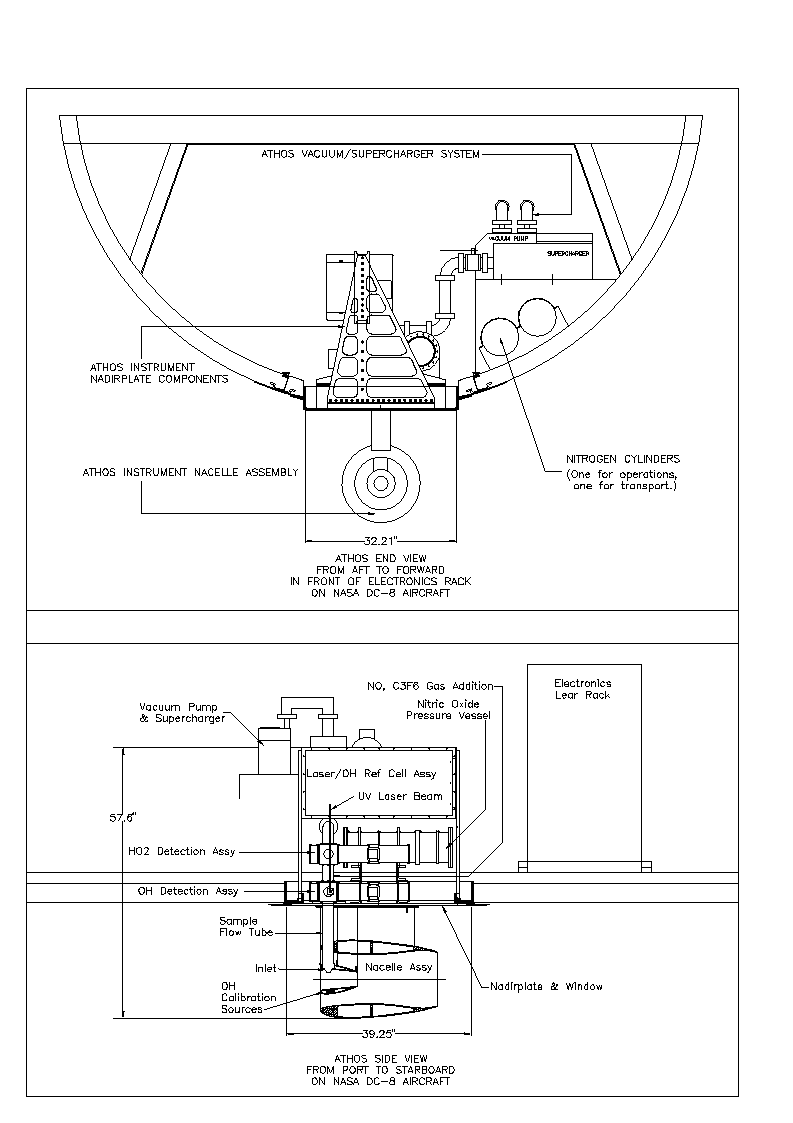
OH and HO2 measurements with the Airborne Tropospheric Hydrogen Oxides Sensor (ATHOS)
William Brune, David Tan, Ian Faloona, Robert Lesher, Christopher Frame, Thomas Kovacs, and James Simpas
503 Walker Building
Department of Meteorology
Pennsylvania State University
University Park, PA 16802
phone: 814-865-3286
fax:814-865-3663
e-mail:
brune@essc.psu.edu
Instrument Description
ATHOS uses laser-induced fluorescence (LIF) to measure OH and HO2
simultaneously. OH is both excited and detected with the
A2S+(u
'=0) ® X2P
+(u "=0) transition near 308
nm. HO2 is first reacted with reagent NO to form OH and is
then detected with LIF.
The ambient air is slowed from the aircraft speed of 240 m/s to a controlled 8-40 m/s in an aerodynamic nacelle, and is then pulled by a vacuum pump through a small inlet, up a sampling tube, and into two low-pressure detection cells. The first cell is for OH and the second for HO2. Detection occurs in each detection cell at the intersection of the airflow, the laser beam multi-passed through White cells, and the detector field-of-view.
The laser has a 5 kHz pulse repetition frequency, 30 ns long pulses, and is tuned on and off resonance with the OH transition to determine OH fluorescence and background signals. The detector is gated to detect the OH fluorescence after the laser pulse has cleared the detection cell. A reference cell containing OH shows when the laser is on and off resonance with the OH transition.
An in-flight calibration system creates OH and HO2 outside
the detection chamber inlet and is currently used to monitor the relative
sensitivities of the two axes. The absolute uncertainty, which
is determined in the laboratory and maintained in flight with monitors, is
± 40%. The minimum detectable mixing
ratio (S/N =2, 60 seconds) is 0.015 pptv for OH and 0.06 pptv for HO2.
All data are collected at 5 Hz. OH and HO2 signals are
statistically significant at 5 Hz in plumes, but they must be integrated
for more than 20 seconds in clean air to get statistical significance.
ATHOS can detect OH and HO2 in clear air and light clouds from
Earth's surface to the lower stratosphere.
Reference Publications
Brune, W.H., P.S. Stevens, and J.H. Mather, Measuring OH and HO2 in the troposphere by laser-induced fluorescence at low pressure, J. Atmos. Sci., 52, 3328-3336, 1995.
Brune, W.H., I.C. Faloona, D. Tan, A.J. Weinheimer, T. Campos, B.A. Ridley, S.A. Vay, J.E. Collins, G.W. Sachse, L. Jaegle, and D. J. Jacob, Airborne in situ OH and HO2 observations in the cloud-free troposphere and lower stratosphere during SUCCESS, Geophys. Res. Lett., 25, 1701, 1998.
Tan, D., I. Faloona, W. H. Brune, A. Weinheimer, T. Campos, B. Ridley, S. Vay, J. Collins, and G. Sachse, In situ meaurements of HOx in aircraft exhaust plumes and contrails during SUCCESS, Geophys. Res. Lett., 25, 1721, 1998.
A schematic of ATHOS. Top view is looking aft; Bottom view is
looking starboard.
